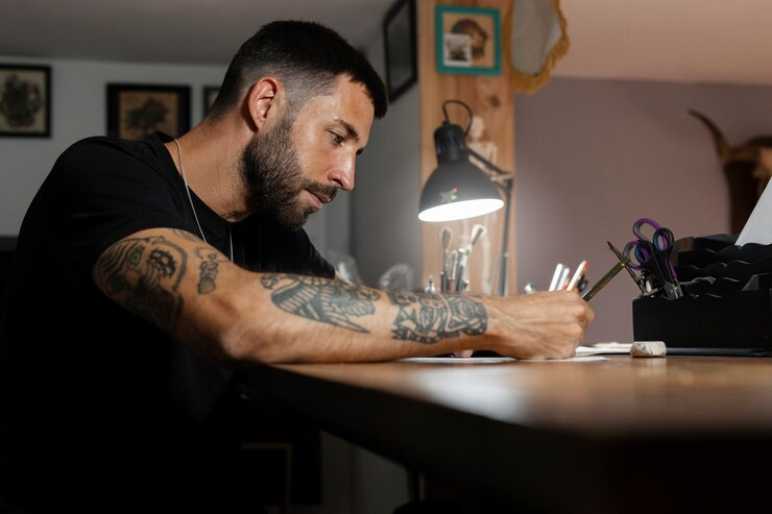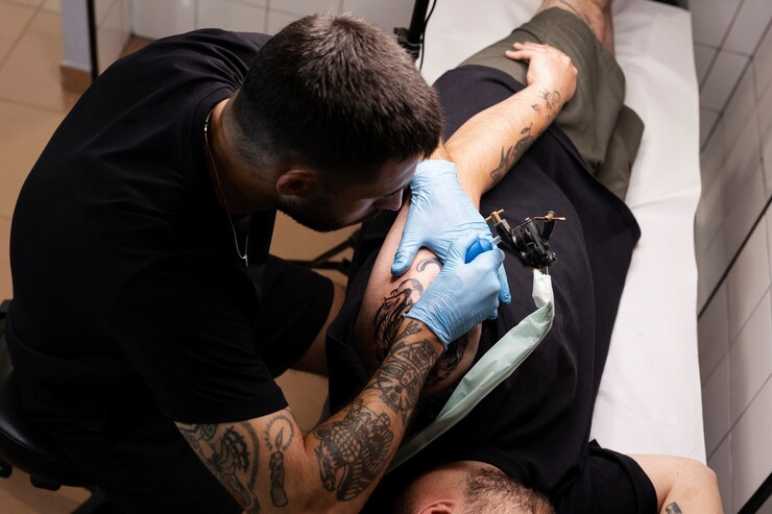Tattooing has evolved into a highly respected art form, with tattoo artists being seen as creative professionals who turn human skin into a canvas. If you’re passionate about body art and want to turn your passion into a profession, becoming a tattoo artist could be a fulfilling and rewarding career choice. This blog will guide you through the essential steps to become a successful tattoo artist, focusing on the skills, training, and professional path you need to follow.
Step 1: Develop Your Artistic Skills

The foundation of becoming a great tattoo artist starts with being an artist. While tattooing is a skill that can be learned, having a natural talent for drawing and an eye for detail is essential. Here’s how you can develop your artistic skills:
Practice Drawing Regularly
Tattoo artists must master drawing because tattoos are permanent, and mistakes can’t be easily erased. Start by drawing every day. Focus on different styles, such as realism, blackwork, watercolor, and geometric designs. Practice sketching on paper and gradually transition to practicing on different surfaces like fruit, synthetic skin, or fake limbs.
Create a Portfolio
Your portfolio is your visual resume, showcasing your skills, creativity, and artistic vision. Aspiring tattoo artists should build a portfolio of their best work, emphasizing different styles and themes to show versatility. Include everything from fine lines to detailed portraits to demonstrate your range.
Take Art Classes
Formal education isn’t mandatory, but taking art classes can enhance your understanding of shading, color theory, and composition. Many tattoo artists also study graphic design, illustration, or fine arts. These classes will help you refine your artistic abilities and ensure your work is of professional quality.
Step 2: Learn the Art of Tattooing

Tattooing is a craft that requires hands-on learning, precision, and a deep understanding of hygiene and safety protocols. Here’s what you need to know:
Find a Tattoo Apprenticeship
A tattoo apprenticeship is one of the most crucial steps to becoming a professional tattoo artist. During an apprenticeship, you’ll work under the guidance of a seasoned artist, learning the ins and outs of tattooing, including machine setup, needle depth, and proper skin techniques.
Look for apprenticeship opportunities at well-established tattoo studios like Inkredible Tattoo Studios, where experienced artists can guide you and help you build your skills. Apprenticeships can last anywhere from one to three years, so patience and commitment are essential.
Learn Tattoo Equipment and Techniques
Tattooing involves using specialized equipment such as tattoo machines, needles, and inks. During your apprenticeship, you’ll gain hands-on experience in using these tools correctly. It’s also crucial to learn about different tattoo techniques, such as lining, shading, and coloring.
Mastering tattoo machine control is essential to achieving clean lines and smooth shading. You’ll also need to practice on different skin types and body parts to understand how tattoos heal and how various skin textures respond to ink.
Step 3: Master Health and Safety Protocols

Tattooing involves breaking the skin, so ensuring the highest standards of hygiene and safety is critical. Proper training in sterilization, sanitation, and the prevention of cross-contamination is non-negotiable.
Obtain Certifications
Depending on where you live, you may be required to complete a bloodborne pathogens certification course, which covers infection control and safety procedures. It’s important to research local laws and regulations regarding tattoo artist licensing and certification to ensure you meet all legal requirements.
Many tattoo studios, such as Inkredible Tattoo Studios, uphold strict safety standards, which is crucial to building a solid reputation and ensuring client trust.
Step 4: Build Your Tattoo Portfolio
Your tattoo portfolio is an essential tool for showcasing your skills and attracting clients. Once you’ve completed your apprenticeship and are ready to start tattooing professionally, you’ll need to update your portfolio with your tattoo work.
Include Real Tattoos in Your Portfolio
Potential clients and employers will want to see examples of actual tattoos you’ve completed. Start with small designs, and as you grow more confident, you can take on more complex and larger pieces. Ensure your portfolio reflects your strengths and favorite tattooing styles.
Utilize Social Media
In the digital age, social media platforms like Instagram and TikTok have become vital for tattoo artists to promote their work. Regularly post high-quality photos and videos of your tattoos, behind-the-scenes content, and time-lapses of your tattoo process. Engage with your followers and collaborate with influencers or models to increase your visibility.
Network in the Industry
Attending tattoo conventions and joining local artist communities can help you network with other tattoo artists and potential clients. Building relationships with other professionals will not only enhance your skills but also lead to job opportunities and collaborations.
Step 5: Find Employment or Open Your Own Studio
Once you’ve honed your skills and built a solid portfolio, it’s time to start your professional career as a tattoo artist. You have two primary options: work for an established tattoo studio or open your own.
Work in a Studio
Many tattoo artists begin by working in established tattoo studios, where they can build a clientele and gain experience. Working in a reputable studio allows you to learn from other experienced artists and benefit from an existing customer base. Look for opportunities at recognized studios like Inkredible Tattoo Studios, where you can continue learning while making a name for yourself.
Open Your Own Tattoo Studio
If you’re entrepreneurial and want more creative control, opening your own tattoo studio could be a great option. However, running a studio requires a solid business plan, marketing strategies, and compliance with local regulations. You’ll need to invest in tattoo equipment, rent a space, and ensure you have the necessary licenses to operate legally.
Step 6: Keep Learning and Improving
Tattooing is a constantly evolving industry, with new trends, techniques, and tools emerging regularly. To stay competitive and successful, you need to keep learning and improving your craft.
Experiment with New Styles
As a tattoo artist, it’s important to push your artistic boundaries. Stay updated with the latest tattoo trends, such as minimalistic designs, single-needle tattoos, or hyper-realistic portraits. Experimenting with different styles will allow you to offer more to your clients and grow your skill set.
Attend Workshops and Seminars
Tattoo conventions often offer workshops and seminars where you can learn from world-renowned artists and improve your technique. Attending these events will expose you to new ideas and allow you to learn about advancements in tattoo technology and health standards.
Keep Up with Industry Standards
Tattoo industry standards are always changing, especially in terms of safety and equipment. Stay informed about any new regulations and ensure that your studio or practice complies with the latest hygiene and safety protocols.
Conclusion
Becoming a tattoo artist requires dedication, creativity, and hard work. From developing your artistic skills to mastering the craft of tattooing and maintaining safety protocols, it’s a journey that involves continuous learning and practice. Whether you decide to work in an established studio like Inkredible Tattoo Studios or open your own business, the key to success lies in your passion for the art and commitment to your craft. With perseverance, you can turn your love for tattoos into a thriving career.
Have A Look :-
